White Water Kayak Expedition to the Sayan
Mountains,
The reception I received from
most people when I first mentioned back in mid 2011 that I fancied going all
the way to  to take part in a
kayaking expedition down two remote rivers wasn’t really on the positive side.
There was a lot of “Mick” taking.
“You’re going to die”, “it’s too difficult” and “the rivers are too
pushy” were common responses I even had money transferred into my bank account
under the heading of “Siberian Funeral Fund” but to be fair, most of the
comments were said light heartedly and I could understand why they were
said. When I first mentioned the trip I
hadn’t been kayaking that long and in all honestly I knew I wasn’t good enough at
that time to undertake such a trip.
to take part in a
kayaking expedition down two remote rivers wasn’t really on the positive side.
There was a lot of “Mick” taking.
“You’re going to die”, “it’s too difficult” and “the rivers are too
pushy” were common responses I even had money transferred into my bank account
under the heading of “Siberian Funeral Fund” but to be fair, most of the
comments were said light heartedly and I could understand why they were
said. When I first mentioned the trip I
hadn’t been kayaking that long and in all honestly I knew I wasn’t good enough at
that time to undertake such a trip.  for the last year I’ve kayaked as much as
possible and with help from friends at the club I have pushed myself hard in
order to improve my kayaking skills and get myself ready for what turned out to
be an amazing adventure.
for the last year I’ve kayaked as much as
possible and with help from friends at the club I have pushed myself hard in
order to improve my kayaking skills and get myself ready for what turned out to
be an amazing adventure.
The expedition itself consisted
of a 10 day self-supported kayaking trip down two of the remotest rivers in
Siberia’s
The second river was the Biluti which is a tributary of the Kitoy.
The Biluti is a low volume creek  that
is revered by Kayakers in
that
is revered by Kayakers in
During the expedition I kept a dairy to remind me of the exploits that we got up to. The following is exerts from the dairy describing the trip and how I was feeling at the time. So if any of you are vaguely interested in garlic, fish, tinned beef, vodka or even a bit of white water kayaking, if might be worth a read. I hope you enjoy the account and the photos, Roy McHale.
Friday 10th August.
The eve of the trip sees me
frantically running around getting together the last bits of kit I need and
packing them away ready for the journey. I get to bed late and oversleep but
still manage to get down to
 Saturday
11th August 2012.
Saturday
11th August 2012.
After around a ten hour flight
plus a two hour wait in 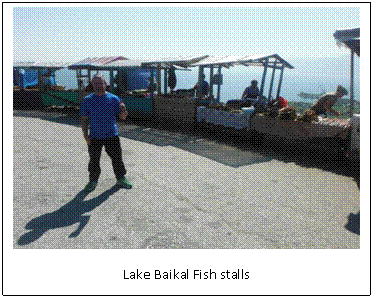 city of over 500,000 people. I am met at the airport by Adidas Sickline team member and Team Pyranha paddler Tomass Marnics who is the
organiser and leader of the expedition. Tomass then
takes me to meet up with the three other English people who are taking part in
the expedition. The English guys, who I’ve never met before are called Alex,
Peter and Andrew. They’re all from the
city of over 500,000 people. I am met at the airport by Adidas Sickline team member and Team Pyranha paddler Tomass Marnics who is the
organiser and leader of the expedition. Tomass then
takes me to meet up with the three other English people who are taking part in
the expedition. The English guys, who I’ve never met before are called Alex,
Peter and Andrew. They’re all from the
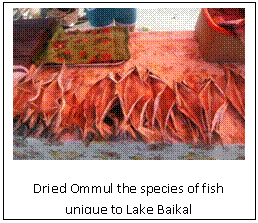 Sunday
12th August 2012
Sunday
12th August 2012
The following morning we were
picked up from the hostel at 9am and go to the lock up
where our kayaks had been stored. There we load our kayaks with the equipment
and clothing we are taking with us and we are also introduced for the first
time to the other members of the expedition. The crew is 10 strong and consists
of Tomass Marnics (Latvia),
Xavier (Belgium), Andre (Czech Republic), Vasiliy, Gresha, Max (Russia) and Myself, Alex, Peter and Andrew
from the UK. We load the boats onto a
truck  which heads off to the put in while we get
some last food supplies and also quite a number of bottles of Russian Vodka for
the trip. Then we set off on a six hour drive to the put in on the
which heads off to the put in while we get
some last food supplies and also quite a number of bottles of Russian Vodka for
the trip. Then we set off on a six hour drive to the put in on the
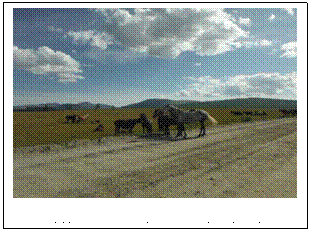
Monday 13th August 2012.
The following morning the
rations were split out equally between each paddler. Breakfast and evening meals on the trip were 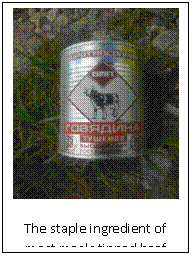 cooked on an open fire but all you got for
Lunch was one Snickers bar per day. After breakfast we began the long first
full day paddle with loaded boats. At
the start of the trip the
cooked on an open fire but all you got for
Lunch was one Snickers bar per day. After breakfast we began the long first
full day paddle with loaded boats. At
the start of the trip the 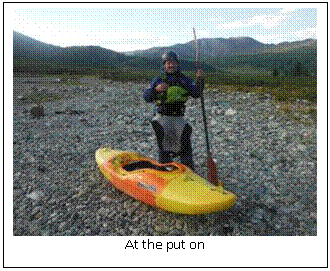 had
been heated in the fire.
had
been heated in the fire.
Tuesday 14th August. The
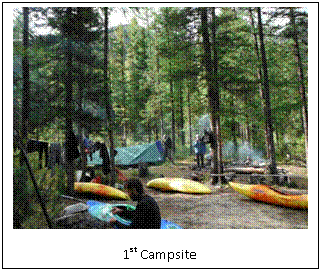 The following day the river was joined by a number
of tributaries which made it deeper, faster and more interesting and after an
hour of paddling we entered the upper canyon and came across the first major
rapid of the trip. This was the first rapid we had scouted Tomass
explained the line and then ran the rapid successfully. The rapid looked scary
but the portage wasn’t nice either so I decided to go for it I capsized quite
near the top rolled up somewhere near the middle then capsized again before
rolling up at the bottom Alex from Cambridge ran the rapid too and did the same
after seeing both Alex and I mess it up Max, Sava and Andrew decided the
portage was the better option.
The following day the river was joined by a number
of tributaries which made it deeper, faster and more interesting and after an
hour of paddling we entered the upper canyon and came across the first major
rapid of the trip. This was the first rapid we had scouted Tomass
explained the line and then ran the rapid successfully. The rapid looked scary
but the portage wasn’t nice either so I decided to go for it I capsized quite
near the top rolled up somewhere near the middle then capsized again before
rolling up at the bottom Alex from Cambridge ran the rapid too and did the same
after seeing both Alex and I mess it up Max, Sava and Andrew decided the
portage was the better option.
The rest of the canyon had some
excellent grade 4 white water rapids which certainly kept you on your toes as
we left the upper canyon behind the rapids were mainly large wave trains all
the way down to the campsite for the night which was located not far above the
upper canyon of the Motkin gorge which is one of the
test pieces of the trip. The campsite this night was probably the best we
stayed at both for the 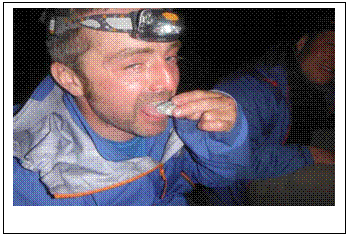 beautiful scenery and for the fishing. I went
down river a few hundred meters to fish and ended up catching 10 fish my tally
was added to the rest of the fish which had been caught mainly by the Russians Vasiliy, Gresha and Max and after
our main evening meal which was a dish of pasta, garlic and tinned beef we all
got stuck in and cleaned and gutted the fish. The larger fish were seasoned
with garlic, mayonnaise and pepper and then wrapped in tin foil and roasted in
the embers of the fire, the smaller fish were either boiled and made into a
beautiful scenery and for the fishing. I went
down river a few hundred meters to fish and ended up catching 10 fish my tally
was added to the rest of the fish which had been caught mainly by the Russians Vasiliy, Gresha and Max and after
our main evening meal which was a dish of pasta, garlic and tinned beef we all
got stuck in and cleaned and gutted the fish. The larger fish were seasoned
with garlic, mayonnaise and pepper and then wrapped in tin foil and roasted in
the embers of the fire, the smaller fish were either boiled and made into a 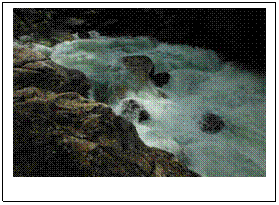 soup or salted and left for a few hours
before being eaten raw because we had caught quite a substantial amount of
fish. Even the livers, stomachs and any
fish eggs that were found while gutting the fish were saved cleaned and fried
up and served with a sort of homemade coleslaw made from cabbage, mayonnaise
and garlic. I know that this fish offal starter sounds disgusting but I must say
it was quite nice, much nicer than the fish head delicacy I tried later in the
evening. During the whole evening neat Vodka was being passed around freely I
think Max was still celebrating his birthday. At one point I’m handed the cup
of vodka and some of the raw salted fish I eat the fish then drink the Vodka I
suppose it was a bit like a tequila slammer but more fishy.
soup or salted and left for a few hours
before being eaten raw because we had caught quite a substantial amount of
fish. Even the livers, stomachs and any
fish eggs that were found while gutting the fish were saved cleaned and fried
up and served with a sort of homemade coleslaw made from cabbage, mayonnaise
and garlic. I know that this fish offal starter sounds disgusting but I must say
it was quite nice, much nicer than the fish head delicacy I tried later in the
evening. During the whole evening neat Vodka was being passed around freely I
think Max was still celebrating his birthday. At one point I’m handed the cup
of vodka and some of the raw salted fish I eat the fish then drink the Vodka I
suppose it was a bit like a tequila slammer but more fishy.
Wednesday 15th August the Upper Canyon of the Motkin Gorge
A fantastic
day paddling on amazing white water.
I started feeling nervous, probably due to the amount of vodka/fish
slammers I’d drank the night before but ended up really enjoying the run and
paddling really well. The river here was fast
and high and we were running the pretty continuous grade 4 rapids through the canyon
for most of the day. Paddling a loaded boat in that type of water is tiring
though and by the end of the run 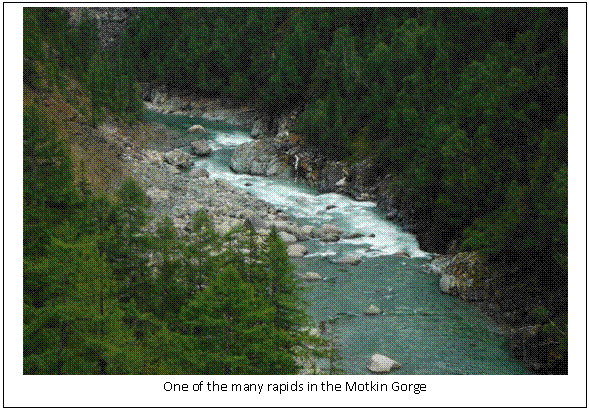 my arms and shoulders were really feeling it
also because a loaded boat is much heavier you need to make technical decisions
about what line you’re going to take a lot earlier than you would with an empty
boat so it’s mentally taxing too. All the rapids on this section of river we
read and run from our kayaks apart from the last which we got out and inspected
as Tomass said it was more difficult than the rest
but to be honest it didn’t look much different than anything we’d been running
all day. There was a definite line that needed taking though and we watched as Tomass ran it. I ran the rapid smoothly the last drop had a
sticky hole beneath it that I managed to punch through with no major problems
apart from being fishtailed slightly. The next section of river was “Rapid 47 ”
which is a grade 6 section and a
mandatory 2 kilometre portage it was our first experience of carrying fully
loaded boats on our backs through the forest and it was hard especially going
up the steep hills but I made it ok. That night we camped in between the upper
and lower canyons of the Motkin gorge the setting of
the camp was beautiful and without any light pollution the amount of stars in
the clear night sky was unreal. The vodka had run out so we drank black tea
before getting a reasonably early night. The lack of Vodka and early night was
probably a good thing as the
my arms and shoulders were really feeling it
also because a loaded boat is much heavier you need to make technical decisions
about what line you’re going to take a lot earlier than you would with an empty
boat so it’s mentally taxing too. All the rapids on this section of river we
read and run from our kayaks apart from the last which we got out and inspected
as Tomass said it was more difficult than the rest
but to be honest it didn’t look much different than anything we’d been running
all day. There was a definite line that needed taking though and we watched as Tomass ran it. I ran the rapid smoothly the last drop had a
sticky hole beneath it that I managed to punch through with no major problems
apart from being fishtailed slightly. The next section of river was “Rapid 47 ”
which is a grade 6 section and a
mandatory 2 kilometre portage it was our first experience of carrying fully
loaded boats on our backs through the forest and it was hard especially going
up the steep hills but I made it ok. That night we camped in between the upper
and lower canyons of the Motkin gorge the setting of
the camp was beautiful and without any light pollution the amount of stars in
the clear night sky was unreal. The vodka had run out so we drank black tea
before getting a reasonably early night. The lack of Vodka and early night was
probably a good thing as the
Thursday 16th August - Lower Canyon Motkin
Gorge.
We awoke to rain I got straight
into my dry suit so my clothes didn’t get wet.
After a breakfast of beans, tinned meat and garlic we put on the river
and within 50 meters of the campsite we’re straight into class 4/4+ rapids with
no chance of a warm up after 30 minutes or so of this we eddie out and inspect
a major rapid there’s a drop that you need to run then about 10 meters
downstream there is a large stopper that you need to avoid I’m feeling tired
after yesterday’s paddle and portage and don’t really fancy running it but the
portage over the large slippery rocks would be horrible so I decide to give it
ago. I break out of the eddie and approach the drop I
miss time my boof stroke which results in me
capsizing in the churning water below. The powerful water doesn’t make setting
up for the roll easy and the approaching stopper is in my mind so I pull my
deck and swim luckily both me and the boat miss the stopper and end up in a
eddie at the bottom of the rapid where I can empty my boat and sort myself out.
Alex runs the rapid after me and does the same after watching both me and Alex
swim Max,
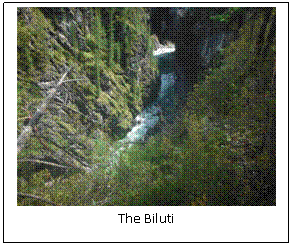 Friday 17th August - The Long
Walk to the Biluti base camp.
Friday 17th August - The Long
Walk to the Biluti base camp.
“Nothing in this life is for
free” was a phrase spoken a few times during the trip or in other words if you
want something you need to pay for it and the cost for running the Biluti is the pain and sweat caused by two days of hiking
through 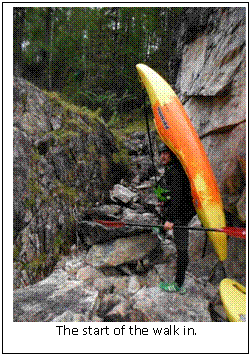 trackless wilderness with a loaded kayak
strapped to your back. We set off on the hike around 11am boats strapped to
backs by an array of “
trackless wilderness with a loaded kayak
strapped to your back. We set off on the hike around 11am boats strapped to
backs by an array of “
The hike goes on for around 6 hours until we reach a tributary that over
the millennia has cut a deep ravine into the mountainside. We need to cross this ravine to get to the
base camp which is situated high up on a cliff between the upper and lower
canyons of the Biluti. Throw lines are rigged up and
the boats are winched across the ravine whilst we need to climb down the
slippery near vertical ravine walls cross the tributary then climb up the other
side. I suppose it was a bit like a Via Ferrate but without any safety rails to
clip into. Once reunited with our boats they go back on our backs for a short
hike to the base camp which is only a few hundred metres away. Once there we go about our daily routine of
collecting wood and water and once the fire is going and the evening meal
cooking we put up the tarps and you get your sleeping bag and matt out and set
up before it goes dark. As always all your dry bags especially ones containing
food need to be hung up so the mice are unable to get at any food. Over the evening meal we talk about the
portage and the upper canyon of the Biluti. Peter decides he has had enough carrying
boats through forests and won’t be going any further up. Tomass
tells me and Alex that if we make it to the upper canyon we will be the first
Brits to do so. We go to bed hopeful that everything will work in our favour and
we can reach the upper canyon.
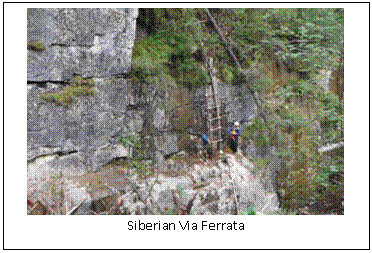 Saturday
18th August - Hike to the upper Canyon.
Saturday
18th August - Hike to the upper Canyon.
We awoke to steady rain that had
completely soaked the forest, part of me thought this may affect water levels
and we wouldn’t be able to paddle the upper canyon, but the rain stopped after
a few hours. We spent most of the day around the camp collecting fire wood and
wild foods whilst the forest dried off. The Russians, especially 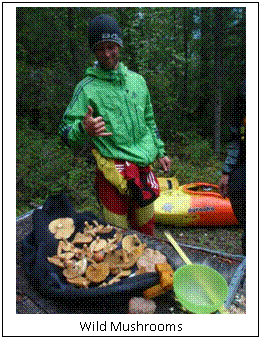 Gresha, were really
good at identifying edible mushrooms and berries and came back with a haul of
them which we cooked and ate.
Gresha, were really
good at identifying edible mushrooms and berries and came back with a haul of
them which we cooked and ate.
At around 5pm we started the hike to the put in of the upper canyon. Again the pace was fast but this time we had empty boats as the plan was to carry the boats up then come back to the base camp for the night before hiking up again the following morning with the rest of our paddling gear to run the river. I found it much easier to keep up carrying an empty boat and was up near the front for most of the way. The terrain underfoot was treacherous and you had to keep switched on as one wrong step could result in a sprain, fracture or worse. Every so often the trees would thin and you would catch a glimpse of the river deep in the canyon below it looked awesome.
After just over 3 hours we reached the put in and as we checked out the first 6 meter drop and which I thought looked “scary as Hell”. We heard voices calling from the other side of the river. It turned out to be Tomass’s brother in law and 3 of his friends who were hiking in the area. They knew we were trying to make the put in on or around the 18th and thought they’d try and meet us, which by chance, they did. They decided to come back to camp with us and we helped them cross the river. By the time they had made it across the sun was setting fast and we knew we’d have to hurry back to camp before darkness fell as it would be dangerous walking around the forest at night. We set off at a fast pace which got faster and faster until we were running and we ended up running all the way back to the camp. We lost the trail a couple of times in the gloom but found it again thanks to Vasiliy. We finally made camp just in time it had taken around 1 hour 15 and for the last 10 minutes or so we’d been running through the dark with head torches on. After the evening meal the group quickly made their way to bed ready for the big day tomorrow.
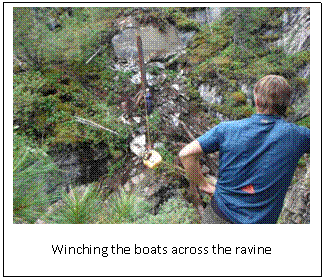 Sunday
19th August – The Biluti
Sunday
19th August – The Biluti
After breakfast we break camp we
stash everything apart from our paddling clothing and equipment down by the
river ready to pick up later. It takes
us 2 hours or so to hike back up to the put in and everyone gets quickly get on
the water. I feel nervous about running
the first waterfall which is a 6 meter high drop into a churning pool the lead
in to the drop is quite technical as well but as usual the portage is probably
more dangerous so I decide to go for it.
I break out of the eddie and head down the
rocky lead in I’m travelling fast and I get past what seems to be the hardest
section with no problems then I go and capsize around three 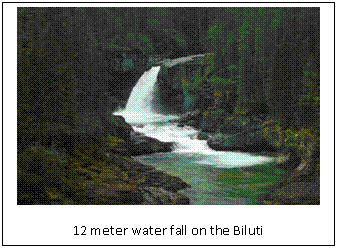 meters from the lip of the drop. I roll up
just as the bow of the kayak is on the lip with no time for a “boof”. I pencil in to
the churning pool below where I’m given a good beating under the waterfall and
with no chance of escape, I pull my deck and swim. The water is extremely cold
and saps my energy quickly. I’m thrown
a line with a karabiner on which I have to reach around and attach to the
harness on my buoyancy aid then I swim back under the falls to retrieve my
kayak.
meters from the lip of the drop. I roll up
just as the bow of the kayak is on the lip with no time for a “boof”. I pencil in to
the churning pool below where I’m given a good beating under the waterfall and
with no chance of escape, I pull my deck and swim. The water is extremely cold
and saps my energy quickly. I’m thrown
a line with a karabiner on which I have to reach around and attach to the
harness on my buoyancy aid then I swim back under the falls to retrieve my
kayak.
The next obstacle after I’m back
in my boat is trying to avoid a stopper at the bottom of another drop by riding
a cushion wave that sweeps around the drop from left to right. I see Tomass run it and he makes it look so easy I try to follow
his line but the hole seems to have a magnetic effect on the stern of my kayak
and as I attempt to ride the cushion wave I get pulled backwards into the hole.
Again I find myself pulling my deck and swimming this time my boat goes down
the next drop on its own. To get past
this next drop I need to climb part way up the canyon wall and walk along a
ledge before jumping 20+ feet back into the river and swimming to the other
side where Vasiliy has already emptied my boat. Two
swims in less than 100 hundred metres of the put in not a good start to the day
but over the next few rapids there are other swimmers and during the time it
takes to 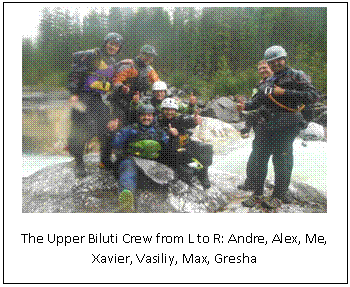 get them back in their boats I have a chance
to compose myself and eat my last Snickers bar to give me some much needed
energy. The rest of the upper canyon went past in a blur. Most of the rapids were grade 4+ boulder
gardens and there were also numerous shoots, slides and drops. There was also two difficult portages, the first around a series
of drops, the second was around a 12 metre waterfall that 2 of the group ran
but I didn’t fancy it. The last difficult rapid of the upper canyon was a
double drop which half the group ran and half portaged. I portaged and watched the others run it
there were various lines taken some successful, others not so. There were a couple of swimmers.
get them back in their boats I have a chance
to compose myself and eat my last Snickers bar to give me some much needed
energy. The rest of the upper canyon went past in a blur. Most of the rapids were grade 4+ boulder
gardens and there were also numerous shoots, slides and drops. There was also two difficult portages, the first around a series
of drops, the second was around a 12 metre waterfall that 2 of the group ran
but I didn’t fancy it. The last difficult rapid of the upper canyon was a
double drop which half the group ran and half portaged. I portaged and watched the others run it
there were various lines taken some successful, others not so. There were a couple of swimmers.
We had now finished the upper canyon and it was around 4.30pm and we still had
the lower canyon to run and once we made the confluence around another 2 hours
down the Kitoy to the hunter’s lodges where we were
staying the night. We needed to make the
lodges as we had not much food left. The Biluti, as
it runs through the lower canyon is continuous grade 4 but there are no high
drops which I was glad of. We had to hurry and as with the upper canyon my
memory of the river is just a blur which is a real shame as it is a truly spectacular
place and it would have been nice to be able to take it slower and enjoy it
more. We finally made the hunters lodges at around 10pm and for the last 20mins
or so we’d been paddling the Kitoys big volume rapids
in almost full darkness. Avoiding massive
holes in the failing light was certainly an experience.
There is a caretaker at the lodges who
is called Viktor. Tomass
has known Viktor for years and stays at the lodges a few times each season he
had sent some supplies to him in the way of cigarettes, vodka and chocolate 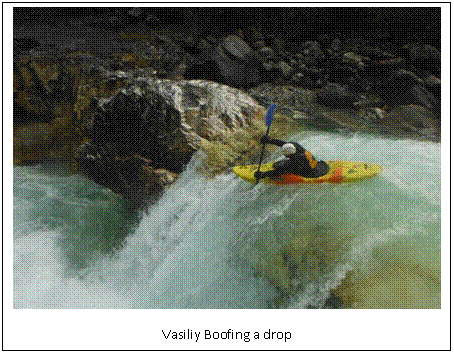 and in return he supplied us with some food
and we stayed the night in log cabins that had wood burners in them. We got the burners going and managed to dry
all of our kit over the next couple of hours.
There was also a Russian Banya there which is
a type of sauna and we washed with warm water for the first time in eight days.
As I lay in bed totally shattered I reflected on the day I had just had and how
tough and exciting it had been from the start right up to the end. It had been
a true epic.
and in return he supplied us with some food
and we stayed the night in log cabins that had wood burners in them. We got the burners going and managed to dry
all of our kit over the next couple of hours.
There was also a Russian Banya there which is
a type of sauna and we washed with warm water for the first time in eight days.
As I lay in bed totally shattered I reflected on the day I had just had and how
tough and exciting it had been from the start right up to the end. It had been
a true epic.
Monday 20th August - The Hunters lodges
Max and Xavier where in the same
lodge as I was and when we awoke in the morning we got the fire going so we
could finish drying off kit. We also boiled water for coffee by sitting our tin
mugs directly on the wood burning stove. We sat around drinking coffee, eating
boiled sweets and chatting about the previous few days. Around mid-morning other people started to
emerge from their respected lodges and we all gathered at the communal open
sided kitchen to find out what was the plan for the day. We had collected
together what rations we had left and there wasn’t enough for the rest of our
journey. Tomass
spoke to Viktor in Russian and after what seemed like some bartering he gave us
some supplies which included some tins of beef, some split peas, some packet
mash and a block of cured pig fat called “Salo” which
I found out is a popular food in Russia. While we talked about the plan for the
day I cut up the pig fat and we mixed it in with a sort of watery potato soup
that Tomass had made from the packet mash and some
garlic. To accompany the meal we also had some slices of the stalest bread I’d
ever seen  (if you’d have dropped a piece on your foot
you’d of definitely known about it). Saying that, not a morsel was left of either the bread or soup when
I’d finished.
(if you’d have dropped a piece on your foot
you’d of definitely known about it). Saying that, not a morsel was left of either the bread or soup when
I’d finished.
As we ate we ended up speaking
about various things and then Tomass told us a story
about Viktor the caretaker at the lodges.
It was hard to determine Viktor’s age but I’d say he was around 60ish
and he lived alone at the lodges for the full 12 months of the year. During the
short summer season he had hikers, fishermen, hunters and a few groups of
Kayakers staying at the lodges for a night or so. During the long winters he would only get a
few hunters passing through. Viktor
walked with a stick and had a limp and I hadn’t given this much thought until Tomass told us why. During one winter season a few years
earlier Viktor had been out hunting in the snow when he mistakenly walked into
a bear trap. The bear trap was a trip wire that was attached to a rifle. As he tripped the wire the rifle went off and
the bullet went through his knee. It took him 2 days to crawl back through the
snow to the lodges and then it took another 5 days for him to manage to get
down the Kitoys big volume rapids in the small flat
bottomed boat he kept at the lodges for ferrying guests across the river. It
was a full 7 days after the accident that he managed to reach the 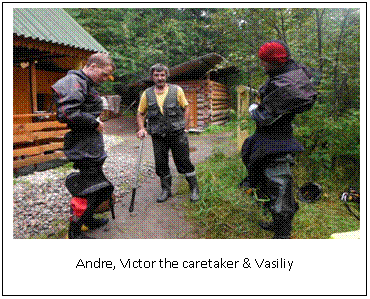 hospital and by that time his leg needed to
be amputated. He now has a wooden leg, so no wonder he walks with a limp. I concluded
from the story that the Siberian wilderness is a hard place to live for both
man and bear.
hospital and by that time his leg needed to
be amputated. He now has a wooden leg, so no wonder he walks with a limp. I concluded
from the story that the Siberian wilderness is a hard place to live for both
man and bear.
The Long paddle;
We said our goodbyes to Viktor
and left the lodges at around 3pm. From the lodges to the get out of the river
it takes between 10 & 11 hours of paddling so the plan was to paddle for 6
hours then make our final camp before continuing the next day to the get out
where we would be met by the trucks. The Kitoy here
was still big volume and you had to keep on your toes but the rapids weren’t continuous
and you had chance to enjoy the mountain vistas as you floated on down. Whilst
we had slept in the lodges the previous night there must have been a storm up
in the mountains as the snow line was lower down the mountains than before and
there was also a real chill in the air. We stopped after a long and uneventful
6 hour paddle and made camp at the side of the river, spirits were generally
low probably due to lack of food and the cold. The first priority was making a
fire then we sorted the tarps and bedding whilst Tomass
cooked the evening meal. After the tarps were up we sat around the fire eagerly
waiting for the meal that consisted of split peas with tinned beef to be cooked
as we were waiting Tomass produced a loaf of fresh
homemade bread that had been made by Viktor. The bread was cut into equal
pieces and we ate it with a topping of “Sgushenka”
which is condensed and sweetened milk it was lovely and tasted a bit like an
iced bun it seemed like a real treat to me as I’d eaten my last Snickers on the
Biluti.
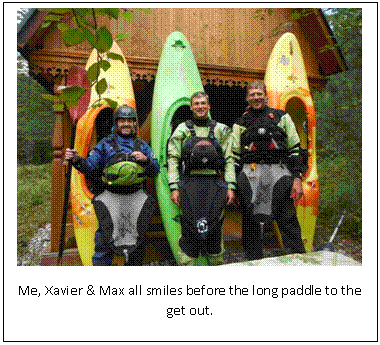
Tuesday 21st
August
During the night the temperature had dropped quite a lot and in the morning
Buoyancy Aids and sleeping mats were frozen solid. We quickly made the
fire and tried to get warm. After
breakfast we set out on the final leg down to the get out. The river here was
wide and every so often would split into different channels around islands. After not more than 10 or 15 minutes the
group had spread out so much that each paddler was paddling alone with only the
odd glimpse now and again of someone else either in front or behind. The only rapids were on the sweeping bends
and after the rapids there were usually long sections of turbulent and slow
moving water that took a lot of energy to paddle through. Eventually, after 5 long hours of paddling, I
reached the get out which was at a small village. Max and Xavier had reached
the village first and had bought a crate of beer and some crisps from the
village store and as each member of the group arrived we were treated to a beer
and some crisps. The drive back to
Since I’ve been home loads of people have asked me did I enjoy the trip and the
answer is always a big “YES”. It was an overall amazing experience that someday
I would love to be able to do again. If
anyone is interested in hearing more about the trip I’ll be doing a talk about
it on Monday 10th
December at The Liverpool Marina Bar. You can also watch a short film that was
made by Tomass called Siberian Summer which shows the
rivers that we we’re running click here http://vimeo.com/48600923
Cheers